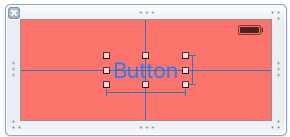标签:
最近在学习Swift ,发现青玉伏案大神早期用OC写的一篇博客--IOS开发之自定义Button(集成三种回调模式) 很适合用来熟悉Swift的回调方式,于是我就用Swift翻版了一下,具体实现原理就不多说了,主要贴上Swift的代码给大家看看。由于刚开始了解Swift,有使用不恰当的地方请轻拍。。。。
上代码:
1、新建一个xib,拖一个UIView到界面上,绑定上自定义的UIView类,拖一个UILabel到view上,写上Button假装是个UIButton;并将label拖到代码当中


2、我这里回调三种Button点击事件,TouchDown、TouchUpInside、TouchUpOutside
A、首先是Target:
a、首先声明一个枚举来设定点击类型
enum MyControlEvents{
case TouchUpInside
case TouchUpOutside
case TouchDown
}
b、设置Target、action和Event三个属性
//声明三个属性、添加一个addTarget方法,注意Target和delegate一样要用weak修饰
weak var target:AnyObject?
var action:Selector?
var controlEvents:MyControlEvents?
func addTarget(target:AnyObject!, action: Selector!, forMyControlEvents controlEvents: MyControlEvents! ){
self.target = target
self.action = action
self.controlEvents = controlEvents
}
c、在touch事件的代理里面实现Target方法、并把label的颜色改改,这样才像button,我把代理方法写在了extension延展里面,因为我见苹果都这样
extension MyViewButton{
override func touchesBegan(touches: Set<UITouch>, withEvent event: UIEvent?) {
self.titleLabel.textColor = UIColor.lightGrayColor()
if self.controlEvents == MyControlEvents.TouchDown{
self.target?.performSelector(self.action!, withObject: self)
}
}
override func touchesEnded(touches: Set<UITouch>, withEvent event: UIEvent?) {
self.titleLabel.textColor = UIColor.blueColor()
//let point:CGPoint = (touches as NSSet).anyObject()!.locationInView(self)、下面方法的合体
let view = (touches as NSSet).anyObject()
let point:CGPoint = view!.locationInView(self)
//判断Target类型和触摸点移出情况相匹配时执行target方法
if CGRectContainsPoint(self.bounds, point) && self.controlEvents == MyControlEvents.TouchUpInside{
self.target?.performSelector(self.action!, withObject: self)
}else if !CGRectContainsPoint(self.bounds, point) && self.controlEvents == MyControlEvents.TouchUpOutside{
self.target?.performSelector(self.action!, withObject: self)
}
}
d、在VC中实现,选择不同的点击类型即可监控不同的点击事件啦
class ViewController: UIViewController , MyViewButtonDelegate {
var myButton:MyViewButton?
override func viewDidLoad() {
super.viewDidLoad()
//从xib中加载我们自定义的view,我的xib叫做“View”
let bundel:NSBundle = NSBundle.mainBundle()
let views:Array = bundel.loadNibNamed("View", owner: nil, options: nil)
self.myButton = views.last as? MyViewButton
self.myButton?.frame = CGRectMake(80, 200, 200, 100)
self.view.addSubview(self.myButton!)
self.myButton?.addTarget(self, action: Selector!("didTapButton:"), forMyControlEvents: MyControlEvents.TouchUpInside)
}
最后 实现点击方法即可
func didTapButton(button:MyViewButton){
print("VC点击了按钮---点击类型是\(button.controlEvents)")
}
B、协议
1、声明一个protocol,里面有三个可选实现的方法,并把自身当做参数带出去
objc protocol MyViewButtonDelegate:NSObjectProtocol{
optional func didTouchMyButton(button:MyViewButton)
optional func didTouchUpInsideButton(button:MyViewButton)
optional func didTouchUpOutsideButton(button:MyViewButton)
}
2、声明一个delegate属性,同样是弱指针引用
weak var delegate:MyViewButtonDelegate!
3、同样在touch事件中实现
extension MyViewButton{
//调用协议方法时判断一下delegate和协议方法是否存在
override func touchesBegan(touches: Set<UITouch>, withEvent event: UIEvent?) {
self.titleLabel.textColor = UIColor.lightGrayColor()
if self.delegate != nil && self.delegate!.respondsToSelector("didTouchMyButton:"){
self.delegate?.didTouchMyButton!(self)
}
}
override func touchesEnded(touches: Set<UITouch>, withEvent event: UIEvent?) {
self.titleLabel.textColor = UIColor.blueColor()
//let point:CGPoint = (touches as NSSet).anyObject()!.locationInView(self)
let view = (touches as NSSet).anyObject()
let point:CGPoint = view!.locationInView(self)
if CGRectContainsPoint(self.bounds, point){
if self.delegate != nil && self.delegate!.respondsToSelector("didTouchUpInsideButton:"){
self.delegate?.didTouchUpInsideButton!(self)
}
}else{
if self.delegate != nil && self.delegate!.respondsToSelector("didTouchUpOutsideButton:"){
self.delegate?.didTouchUpOutsideButton!(self)
}
}
}
}
4、在VC中实现即可
class ViewController: UIViewController , MyViewButtonDelegate {
override func viewDidLoad() {
super.viewDidLoad()
let bundel:NSBundle = NSBundle.mainBundle()
let views:Array = bundel.loadNibNamed("View", owner: nil, options: nil)
self.myButton = views.last as? MyViewButton
self.myButton?.frame = CGRectMake(80, 200, 200, 100)
self.view.addSubview(self.myButton!)
//设置button的代理
self.myButton!.delegate = self
}
extension ViewController{
//实现代理方法
func didTouchMyButton(button: MyViewButton) {
print("delegate--VC点击了button")
}
func didTouchUpInsideButton(button: MyViewButton) {
print("delegate--TouchUpInside")
}
func didTouchUpOutsideButton(button: MyViewButton) {
print("delegate--TouchUpOutside")
}
}
C、闭包(block)
1、首先在自定义view里实现,相当于typedef一个block类型
typealias MyBlock = (button:MyViewButton)->Void
2、声明三个block属性,并且声明三个给block赋值方法
var TouchBlockHandel:MyBlock?
var TouchUpInsideBlockHandel:MyBlock?
var TouchUpOutsideBlockHandel:MyBlock?
//也可以不写方法直接属性赋值
func setMyTouchBlock(block:MyBlock){
self.TouchBlockHandel = block
}
func setMyTouchUpInsideBlock(block:MyBlock){
self.TouchUpInsideBlockHandel = block
}
func setMyTouchUpOutsideBlock(block:MyBlock){
self.TouchUpOutsideBlockHandel = block
}
3、在touch事件中实现block
extension MyViewButton{
override func touchesBegan(touches: Set<UITouch>, withEvent event: UIEvent?) {
self.titleLabel.textColor = UIColor.lightGrayColor()
self.TouchBlockHandel!(button: self)
}
override func touchesEnded(touches: Set<UITouch>, withEvent event: UIEvent?) {
self.titleLabel.textColor = UIColor.blueColor()
//let point:CGPoint = (touches as NSSet).anyObject()!.locationInView(self)
let view = (touches as NSSet).anyObject()
let point:CGPoint = view!.locationInView(self)
if CGRectContainsPoint(self.bounds, point){
self.TouchUpInsideBlockHandel!(button: self)
}else{
self.TouchUpOutsideBlockHandel!(button: self)
}
}
4、同样在VC中给三个block赋值即可
class ViewController: UIViewController , MyViewButtonDelegate {
var myButton:MyViewButton?
override func viewDidLoad() {
super.viewDidLoad()
let bundel:NSBundle = NSBundle.mainBundle()
let views:Array = bundel.loadNibNamed("View", owner: nil, options: nil)
self.myButton = views.last as? MyViewButton
self.myButton?.frame = CGRectMake(80, 200, 200, 100)
self.view.addSubview(self.myButton!)
self.myButton?.setMyTouchBlock({ (button:MyViewButton) -> Void in
print("block--VC点击了button")
})
self.myButton?.setMyTouchUpInsideBlock({ (button:MyViewButton) -> Void in
print("block--VCTouchUpInside")
})
self.myButton?.setMyTouchUpOutsideBlock({ (button:MyViewButton) -> Void in
print("block--VCTouchUpOutside")
})
}
}
最后来看看三个方法写在一起的打印结果。就添加了一个target监控TouchUpInside。总体来说和OC逻辑没有任何变化,只是语法上有所不同,block还是好用

好了,这样就结束了,今天下雪了,大家注意保暖!
标签:
原文地址:http://www.cnblogs.com/xiaoqiuge/p/4943776.html